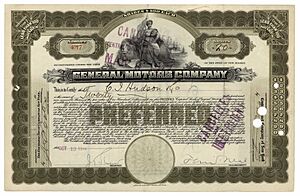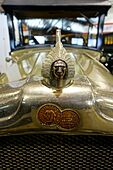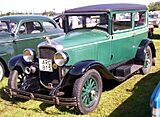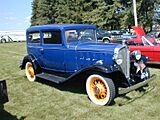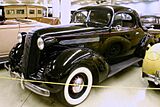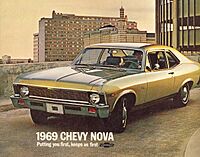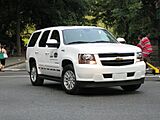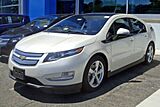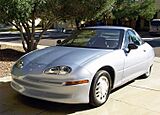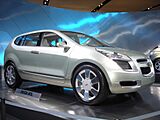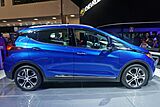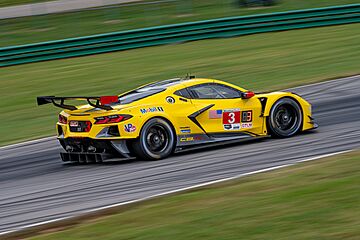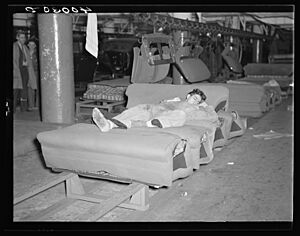General Motors facts for kids
 |
|
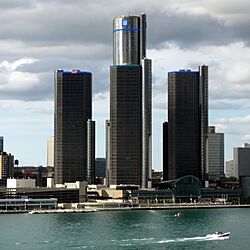
Headquarters at the Renaissance Center in Detroit in 2013
|
|
| Public | |
| Traded as | |
| ISIN | ISIN: [https://isin.toolforge.org/?language=en&isin=US37045V1008 US37045V1008] |
| Industry | Automotive |
| Predecessor | General Motors Corporation |
| Founded |
|
| Chair & CEO | Mary Barra |
| President | Mark Reuss |
| Founder | William C. Durant |
| Headquarters | Renaissance Center,
Detroit, Michigan
,
United States
|
|
Number of locations
|
396 facilities on six continents |
|
Area served
|
Worldwide |
|
Key people
|
|
| Products |
|
| Brands | |
|
Production output
|
|
| Services |
|
| Revenue | |
|
Operating income
|
|
| Total assets | |
| Total equity | |
|
Number of employees
|
162,000 (2024) |
| Subsidiaries |
Financial services
Logistics
Industrial
International
|
General Motors Company (GM) is a big American company that makes cars. Its main office is in Detroit, Michigan, in the United States. GM is famous for its four main car brands: Chevrolet, Buick, GMC, and Cadillac. Each of these is a separate part of GM.
For many years, GM was the largest car maker in the United States. It was also the biggest in the world for 77 years. In 2008, Toyota became the world's largest car maker.
General Motors has factories in eight different countries. Besides its main brands, GM also works with Chinese brands like Baojun and Wuling. GM also has a special division called GM Defense that makes military vehicles. Other parts of GM include OnStar, which provides safety and information services for cars, and ACDelco, which sells car parts. GM also has a financial service called GM Financial.
The company started on September 16, 1908. It was founded by William C. Durant, who was a big seller of horse-drawn vehicles at the time. In its early years, GM grew by buying many other car companies. Later, it focused on new ideas and working with groups like NASA. The company you see today was formed in 2009 after a big reorganization.
In 2024, General Motors was ranked 25th among all American companies by total money earned. It was also 50th on the list of the world's largest companies. GM announced in 2021 that it plans to stop making cars with regular gasoline engines by 2035. This is part of its goal to become a carbon-neutral company by 2040.
History of General Motors
How GM Started and Grew
William C. Durant started the General Motors Company in 1908. He first bought Buick Motor Company in 1904. GM then bought other car companies like Olds Motor Works and Cadillac. It also acquired companies that made trucks, which later became GMC.
Durant tried to buy Ford Motor Company in 1909, but banks would not lend him the money. He bought too many companies, and the board of directors removed him in 1910.
In 1911, Charles F. Kettering helped invent the first electric car starter. In November 1911, Durant started Chevrolet with race car driver Louis Chevrolet. Chevrolet became very successful.
GM became a public company in 1916. By 1917, Durant got control of GM again with help from others. GM also bought companies that made car parts and even refrigerators, which became Frigidaire. In 1919, General Motors Acceptance Corporation (GMAC) was created to help people get loans for cars.
In 1920, Alfred P. Sloan took over as CEO. He introduced yearly model changes for cars. This made older models seem "dated" and created a market for used cars. He also set up a pricing plan for GM's brands. Chevrolet cars were the least expensive, followed by Pontiac, Oldsmobile, Buick, and Cadillac as the most expensive.
In 1925, GM bought Vauxhall Motors in the UK. It also bought a part of Yellow Cab Manufacturing Company, which made taxis.
Expanding and Innovating
In 1926, GM launched the Pontiac brand. The company also started a life insurance program for its employees. After the success of the 1927 Cadillac LaSalle, GM created a special design section. Harley Earl was its first director. He changed how cars were designed, a system still used today.
GM bought Allison Engine Company in 1929 to develop aircraft engines. The same year, GM bought most of Opel, a German car company. It bought the rest of Opel in 1931.
GM also started working on two-stroke diesel engines for vehicles. It bought companies that made train cars and engines. This led to the creation of the Electro-Motive Division (EMD).
In 1935, GM workers joined the United Auto Workers (UAW) union. In 1936, the UAW organized a big strike in Flint, Michigan. This strike helped the union become very strong.
In 1939, GM introduced the Hydramatic. This was the first successful and affordable automatic transmission for cars.
During World War II, GM made many weapons, vehicles, and aircraft for the Allies of World War II. By 1942, all of GM's production was for the war effort. GM's Vauxhall Motors made Churchill tanks. GM also built aircraft for the navies.
In 1953, GM bought Euclid Trucks, which made heavy construction equipment.
New Ideas and Technologies
In 1962, GM introduced the first car with a turbocharger, the Oldsmobile Cutlass Turbo-Jetfire. Two years later, the company launched its "Mark of Excellence" logo.
GM released the Electrovan in 1966. This was the first car powered by a hydrogen fuel cell. GM was the first to use a fuel cell to power a vehicle's wheels.
In 1971, GM helped design the Lunar Roving Vehicle for NASA. This vehicle drove on the Moon's surface. The next year, GM made the first car with a rear-wheel anti-lock braking system.
In 1973, the Oldsmobile Toronado was the first car sold with a passenger airbag.
GM started putting catalytic converters in its cars in 1975. These devices help clean car exhaust.
In 1984, GM bought Electronic Data Systems (EDS) to help with its computer systems. GM also bought Hughes Aircraft Company in 1985. The next year, GM bought most of Lotus Cars, a British sports car maker.
In 1987, GM built the Sunraycer, a solar-powered car that won a race. This car's technology helped create the General Motors EV1 electric car.
In 1989, GM bought half of Saab Automobile's car business.
Changes and New Directions
In 1990, GM showed the General Motors EV1 (Impact) concept car. This was a battery electric vehicle. The EV1 was available for lease in California and Arizona starting in 1996. However, GM stopped making these cars and took them back from customers. Most of them were destroyed.
-
Chevrolet Tahoe hybrid vehicle
-
The Chevrolet Volt
-
The General Motors EV1, an electric car, was introduced in California in 1996.
In 1993, GM sold Lotus Cars. In 1996, GM separated from Electronic Data Systems. In 1997, GM sold the military parts of Hughes Aircraft Company.
In 2000, GM announced it would stop making Oldsmobile cars. The brand was officially discontinued in 2004.
In 2004, GM released its first full-sized pickup truck hybrid vehicles. These were the Chevrolet Silverado and GMC Sierra trucks. GM also worked on other hybrid technologies.
In 2005, GM sold its train engine division, Electro-Motive Diesel. GM also ended its partnership with Fiat.
In 2008, GM started a plan to make half of its factories "landfill-free" by recycling waste. GM also began offering a 2-mode hybrid system in some of its large SUVs and trucks.
Reorganization and Electric Future
In 2009, General Motors went through a major reorganization. The company received help from the government. On July 10, 2009, a new company was formed, taking over GM's assets and brands. This helped the company get rid of many old debts.
As part of its agreement, GM stopped making some of its less profitable brands. These included Hummer, Saab, Saturn, and Pontiac. The last Pontiac car was built in January 2010.
In 2009, GM faced challenges in Asia. It sold a small part of its Shanghai GM business to SAIC Motor. This helped GM get money from Chinese banks.
In 2010, GM introduced the Chevrolet Volt. This was an extended-range electric vehicle (EREV). It was an electric car with a gasoline engine that could charge the battery.
-
E85 FlexFuel Chevrolet Impala LT 2009 (USA)
On January 15, 2014, Mary Barra became the CEO of General Motors. She was the first woman to lead a major car company. Soon after, GM announced a large recall of cars due to faulty ignition switches.
In 2016, GM invested in Lyft, a company that offers ride-sharing services. In March 2016, GM bought Cruise, a company that develops self-driving cars. Cruise received a permit in 2022 to offer fully autonomous rides in a major city.
In October 2016, GM started making the Chevrolet Bolt EV. This was one of the first affordable all-electric cars with a long driving range.
In 2017, GM sold its European car brands, Opel and Vauxhall, to the French company PSA Group. This deal was worth US$2.2 billion.
In 2020, GM announced it would leave markets like Thailand, Australia, and New Zealand. This was because GM decided to stop making right-hand drive vehicles globally.
On January 8, 2021, GM introduced a new logo. It also launched a new brand called BrightDrop for electric commercial vehicles.
On January 28, 2021, GM announced a big goal. It plans to stop making cars that use fossil fuels by 2035. This is part of its plan to become carbon neutral by 2040.
GM is also working with LG Chem Ltd. to get materials for electric car batteries. In January 2024, GM announced it would start making plug-in hybrid electric vehicles (PHEVs) again. This helps balance the supply of electric cars with what customers want.
In April 2024, GM announced it would move its main office in Detroit. It will move from the Renaissance Center to the nearby Hudson's Detroit development in 2025.
In October 2024, General Motors increased its investment in a Canadian mining company called Lithium Americas. This helps GM get more lithium for electric car batteries in the United States.
Motorsport Activities
GM cars have raced in many different motorsport events. These include the World Touring Car Championship, 24 Hours of Le Mans, NASCAR, and Supercars Championship.
GM engines were very successful in the Indy Racing League (IRL) in the 1990s. GM has also designed cars specifically for NASCAR racing. The Chevrolet Camaro ZL1 is currently used in the series. In the past, other GM cars like the Pontiac Grand Prix and Chevrolet Monte Carlo were also raced. Chevrolet has won the most NASCAR Cup Series manufacturer championships.
In Australia, Holden cars raced in the Australian Touring Car Championship until 2022. Holden won the Bathurst 1000 race a record 36 times. Starting in 2023, the Chevrolet Camaro will be raced there.
In November 2024, GM announced plans to enter Formula One racing in 2026. They will race under the Cadillac name, using Ferrari engines at first. They also plan to become an engine supplier later.
GM Logo Over Time
Here's how the GM logo has changed over the years:
GM Car Brands
Current Brands
| Origin | Brand | Founded | Start manufacturing |
Joined GM |
Markets served today |
|---|---|---|---|---|---|
| Chevrolet | 1911 | 1911 | 1918 | Americas, China, Middle East, CIS, South Korea, Philippines, Japan, Australasia | |
| Buick | 1899 | 1903 | 1908 | China, North America | |
| GMC | 1912 | 1912 | 1919 | North America, Middle East, South Korea, China, Australasia | |
| Cadillac | 1902 | 1902 | 1909 | North America, Middle East, China, Japan, South Korea, Europe, Kazakhstan, Australasia | |
| Baojun | 2010 | 2010 | 2010 | China | |
| Wuling | 2002 | 2002 | 2002 | China, Indonesia, Vietnam, Thailand |
Former Brands
| Origin | Brand | Founded | Start manufacturing |
Joined GM |
Fate | Defunct or sold | Notes |
|---|---|---|---|---|---|---|---|
| Acadian | 1962 | 1962 | 1962 | Discontinued | 1987 | A Canadian version of the Chevy II. | |
| Alpheon | 2010 | 2010 | 2010 | Discontinued | 2015 | Based on the Buick LaCrosse. | |
| Asüna | 1992 | 1992 | 1992 | Discontinued | 1994 | Sold Suzuki, Isuzu, and Toyota models. | |
| Beaumont | 1966 | 1966 | 1966 | Discontinued | 1969 | A Canadian version of the Chevelle. | |
| Bedford | 1931 | 1931 | 1931 | Discontinued | 1991 | ||
| BrightDrop | 2021 | 2022 | 2021 | Merged into Chevrolet | 2025 | ||
| Cartercar | 1905 | 1905 | 1909 | Discontinued | 1915 | ||
| Daewoo | 1972 | 1972 | 1999 | Discontinued | 2011 | Replaced by GM Korea. | |
| Elmore | 1893 | 1900 | 1912 | Discontinued | 1916 | ||
| Envoy | 1959 | 1959 | 1959 | Discontinued | 1970 | Sold imported Vauxhall and Bedford cars in Canada. | |
| Epic | 1964 | 1964 | 1964 | Discontinued | 1970 | Sold imported Vauxhall models in Canada. | |
| Geo | 1989 | 1989 | 1989 | Discontinued | 1997 | Sold Suzuki, Isuzu, and Toyota models through Chevrolet dealers. | |
| Holden | 1856 | 1908 | 1926 | Discontinued | 2020 | ||
| Hummer | 1992 | 1992 | 1998 | Discontinued as a division, brand name revived under GMC | 2010 | The name was revived in 2021 for the GMC Hummer EV. | |
| LaSalle | 1927 | 1927 | 1927 | Discontinued | 1940 | A companion brand for Cadillac. | |
| Lotus | 1948 | 1948 | 1986 | Sold to Romano Artioli | 1993 | ||
| Marquette (2) | 1929 | 1929 | 1929 | Discontinued | 1931 | A companion brand for Buick. | |
| McLaughlin | 1907 | 1907 | 1918 | Discontinued | 1942 | Became the basis of General Motors Canada. | |
| Oakland | 1907 | 1907 | 1909 | Discontinued | 1931 | Replaced by Pontiac. | |
| Oldsmobile | 1897 | 1897 | 1908 | Discontinued | 2004 | ||
| Opel | 1899 | 1899 | 1931 | Sold to PSA Group | 2017 | ||
| Passport | 1987 | 1987 | 1987 | Discontinued | 1991 | Sold Suzuki, Isuzu, and Toyota models. | |
| Pontiac | 1926 | 1926 | 1926 | Discontinued | 2010 | Started as a companion brand for Oakland. | |
| Ranger | 1968 | 1968 | 1968 | Discontinued | 1978 | ||
| Saab | 1945 | 1949 | 1990 | Sold to Spyker N.V. | 2010 | ||
| Saturn | 1985 | 1990 | 1985 | Discontinued | 2010 | ||
| Scripps-Booth | 1913 | 1913 | 1916 | Discontinued | 1923 | ||
| Sheridan | 1920 | 1920 | 1920 | Discontinued | 1921 | The first car developed by General Motors. | |
| Statesman | 1971 | 1971 | 1971 | Discontinued | 1984 | A division of Holden. | |
| Vauxhall | 1903 | 1903 | 1925 | Sold to PSA Group | 2017 | ||
| Viking | 1929 | 1929 | 1929 | Discontinued | 1930 | Started as a companion brand for Oldsmobile. |
Business Information
How GM Sells Cars
General Motors was the world's largest car seller for 77 years, from 1931 until 2008. In 2008, Toyota became the largest. GM is still one of the biggest car makers in the world.
In 2008, Brazil was GM's third-largest market, selling about 550,000 vehicles.
In 2009, General Motors sold 6.5 million cars and trucks worldwide. In 2010, this number grew to 8.39 million. Sales in China increased a lot in 2009.
In 2011, GM was back in first place for global sales, selling over 9 million vehicles. The top markets were China and the United States. The Chevrolet brand was a big part of GM's success, selling 4.76 million vehicles worldwide in 2011.
By 2016, GM's worldwide sales reached 10 million vehicles.
The Chevrolet Volt and Ampera electric cars sold about 177,000 units from 2010 to 2018. The Volt family of vehicles was the world's top-selling plug-in hybrid by 2018. It was also the third best-selling plug-in electric car overall.
| Rank in GM |
Location | Vehicle sales |
Market share (%) |
|---|---|---|---|
| 1 | 2,981 | 22.1% | |
| 2 | 1,095 | 12.0% | |
| 3 | 549 | 19.5% | |
| 4 | 384 | 15.4% | |
| 5 | 359 | 21.4% | |
| 6 | 338 | 11.1% | |
| 7 | 300 | 8.8% | |
| 8 | 212 | 19.8% | |
| 9 | 133 | 13.1% | |
| 10 | 117 | 9.7% | |
| 11 | 114 | 4.4% | |
| 12 | 107 | 7.8% | |
| 13 | 95 | 15.5% | |
| 14 | 91 | 33.3% | |
| 15 | 80 | 36.3% | |
| 16 | 66 | 3.3% |
| Year | U.S. sales (vehicles) |
Chg/yr. |
|---|---|---|
| 1998 | 4,603,991 | |
| 1999 | 5,017,150 | |
| 2000 | 4,953,163 | |
| 2001 | 4,904,015 | |
| 2002 | 4,858,705 | |
| 2003 | 4,756,403 | |
| 2004 | 4,707,416 | |
| 2005 | 4,517,730 | |
| 2006 | 4,124,645 | |
| 2007 | 3,866,620 | |
| 2008 | 2,980,688 | |
| 2009 | 2,084,492 | |
| 2010 | 2,215,227 | |
| 2011 | 2,503,820 | |
| 2012 | 2,595,717 | |
| 2013 | 2,786,078 | |
| 2014 | 2,935,008 | |
| 2015 | 3,082,366 | |
| 2016 | 3,042,773 | |
| 2017 | 3,002,241 | |
| 2018 | 2,954,037 | |
| 2019 | 2,887,046 | |
| 2020 | 2,547,339 | |
| 2021 | 2,218,228 | |
| 2022 | 2,274,088 | |
| 2023 | 2,594,698 | |
| 2024 | 2,705,080 |
| Location | Total sales | Year-On-Year change |
Year-On-Year change (%) |
|---|---|---|---|
| GM North America | 3,367,374 | (122,740) | (3.5) |
| GM Europe | 3,590 | (266) | (6.9) |
| GM South America | 668,842 | (21,355) | (3.1) |
| GM International | 584,520 | 28,033 | 5.0 |
| China | 3,093,604 | (551,440) | (15.1) |
| Total | 7,717,930 | (667,768) | (8.0) |
Company Leaders
Current Board of Directors
Here are some important people on GM's board of directors:
- Mary Barra, who is the Chairman and CEO of General Motors.
- Linda Gooden, who used to be a Vice President at Lockheed Martin.
- Joseph Jimenez, who is the CEO of Novartis.
- Jane Mendillo, who used to be the President and CEO of Harvard Management Company.
- Michael Mullen, who was a top military leader.
- James Mulva, who used to be the CEO of ConocoPhillips.
- Patricia Russo, who is the CEO of Hewlett Packard Enterprise.
- Theodore Solso, who used to be the CEO of Cummins.
- Carol Stephenson, who used to be a dean at Ivey Business School.
- Devin Wenig, who used to be the President and CEO of eBay.
- Jon McNeill, who is the CEO of DVx Ventures LLC.
Past Chairmen of the Board
- Thomas Neal (1912–1915)
- Pierre S. du Pont (1915–1929)
- Lammot du Pont II (1929–1937)
- Alfred P. Sloan Jr. (1937–1956)
- Albert Bradley (1956–1958)
- Frederic G. Donner (1958–1967)
- James M. Roche (1967–1971)
- Richard C. Gerstenberg (1972–1974)
- Thomas A. Murphy (1974–1980)
- Roger B. Smith (1981–1990)
- Robert C. Stempel (1990–1992)
- John G. Smale (1992–1995)
- John F. Smith Jr. (1996–2003)
- Rick Wagoner (2003–2009)
- Kent Kresa (2009)
- Edward Whitacre Jr. (2009–2010)
- Daniel Akerson (2010–2014)
- Tim Solso (2014–2016)
- Mary Barra (2016–Present)
Past Chief Executive Officers
- Alfred P. Sloan Jr. (1923–1946)
- Charles Erwin Wilson (1946–1953)
- Harlow H. Curtice (1953–1958)
- James M. Roche (1967–1971)
- Richard C. Gerstenberg (1972–1974)
- Thomas A. Murphy (1974–1980)
- Roger B. Smith (1981–1990)
- Robert C. Stempel (1990–1992)
- John F. Smith Jr. (1992–2000)
- Rick Wagoner (2000–2009)
- Frederick Henderson (2009)
- Edward Whitacre Jr. (2009–2010)
- Daniel Akerson (2010–2014)
- Mary Barra (2014–Present)
Labor Relations
Most of General Motors' American workers are part of the United Auto Workers (UAW) union.
The Flint Sit-Down Strike
The 1936–1937 Flint sit-down strike was a very important event. It helped the UAW union become strong in the car industry. Workers stopped working but stayed inside the GM factories in Flint, Michigan.
Organizing in Flint was difficult because GM had a lot of control in the city. GM also had spies in its factories. This meant union members had to keep their names secret.
The UAW found that GM had only two factories that made the main parts for car bodies. One was in Flint, and the other was in Cleveland, Ohio.
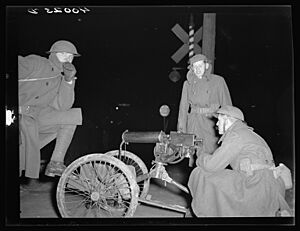
During the strike, police tried to enter a factory in Flint. The workers inside fought back. The President of the United States, Franklin D. Roosevelt, urged GM to work with the union. The strike lasted 44 days.
Finally, GM agreed to talk with the union. The Governor of Michigan helped both sides reach an agreement. The strike ended on February 11, 1937. GM agreed to recognize the UAW as the main union for its workers.
Strikes in Recent Years
- 2007 General Motors Strike: From September 24 to 26, 2007, UAW workers went on strike against GM. This was the first US-wide strike against GM since 1970. It stopped work at 59 factories. The strike ended quickly when a new agreement was reached.
- 2019 General Motors Strike: On September 15, 2019, UAW workers went on strike again. This strike lasted 40 days and shut down many factories. It was the longest strike against GM since 1970. The strike ended on October 25, 2019, when workers approved a new contract.
- 2023 United Auto Workers Strike: In 2023, the UAW launched a strike against all three major American car makers, including GM. The UAW president, Shawn Fain, said workers were unhappy with wages and other issues. GM's CEO, Mary Barra, said the company offered a good deal. The strike aimed to improve conditions for workers.
Community Support
General Motors has supported many good causes.
From 1976 to 2017, GM had a foundation called the General Motors Foundation. This foundation helped with many charitable activities.
GM works closely with the Nature Conservancy. It has helped raise money and donated vehicles to this environmental group.
Since 1997, GM has funded the "Safe Kids Buckle Up" program by Safe Kids Worldwide. This program teaches about child car safety.
See also
 In Spanish: General Motors para niños
In Spanish: General Motors para niños
- Alliance of Automobile Manufacturers
- EcoCAR
- General Motors proving grounds
- General Motors Technical Center
- List of automobile manufacturers of the United States
- List of GM engines
- List of General Motors factories
- List of General Motors platforms
- List of GM transmissions


